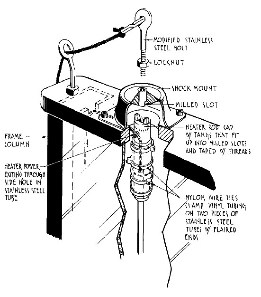| unsatisfactory. The screen was too small and the water rose further in the tank than could be projected onto the screen. The calrod coil was too wide so that the convection shadows (schlieren) appeared fuzzy and unduly irregular. The calrod started to rust, so it was painted with epoxy. But the epoxy prevented the water from wetting it properly. The magnified projected surface of the calrod looked bumpy and ugly because of the air bubbles that adhered to the epoxy. | with the calrod to see what could happen. The mounting was therefore changed so that the calrod could not move sideways and hit the glass but could have considerable motion parallel to the glass. We ran a string from the protruding calrod support over a pulley to a ring on the side of the tank. It was quite pleasant to pull the string and stir the water. The exhibit now has an intriguing operational aesthetic. It is both entertaining and instructive to move the light and observe the change in scale of the shadow on the wall. When one first turns the heater on, a thin warm layer-forms around it that does not rise, a kind of "inversion". With a little more heat, the warm water breaks away from the heater, it rises smoothly for a few inches and then develops two swirls, one each side, rotating in opposite directions. With full heat, there is much turbulence and if one pulls the string up and down one observes threads of warm water that appear throughout the tank and persist for a surprisingly long time. It is not as easy to produce a uniform mixture by stirring as I had supposed. If one waits, with the heater off, till the threads have disappeared and then stirs again, the threads reappear. We were puzzled by this reappearance until someone pointed out that, after the heater had been on for a while, there is a gradual temperature increase from the bottom to the top of the tank that remains static. It becomes rearranged when one stirs the quiet tank and the shadows show the resulting inhomogeneities. The exhibit now is lovely, instructive, and as so often happens when one makes one's own exhibits, full of both aesthetic and phenomonological surprises for the exhibit creators. The exhibit is so "nice" that, instead of putting it where it belongs in the section on Heat and Temperature, we leave it between the main entrance and our office so that visitors can see it when they first come in and so that we can readily play with it and show it to friends. In describing this exhibit I have discussed only its operation and have left out an equally long description of all the little problems and decisions that were involved in its fabrication. In many instances removing unpleasant frustrations in the operation of an exhibit can | ||
 | |||
| We put up with this exhibit for many months and then completely redesigned it. We made a much thinner tank and used a one inch long, 1/4" diameter horizontal heating element. We placed a shielded point source light in front of the tank on a slide so that it could move from about four to fourteen inches away from the glass wall of the tank. The shadow image of the convection current stream was projected on a broad expanse of a wall a few feet behind the tank. The rod that supported the calrod extended a short distance above the top of the tank. It could be moved, but initially its motion was frustratingly restricted because someone was worried that the visitor might knock the heater against the wall of the tank and break the glass. I did not like the feel of this restricted motion and wanted to be able to stir the water | |||